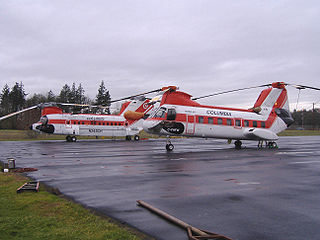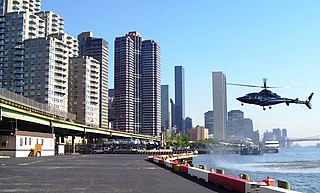
The Boeing Vertol CH-46 Sea Knight is an American medium-lift tandem-rotor transport helicopter powered by twin turboshaft engines. It was designed by Vertol and manufactured by Boeing Vertol following Vertol's acquisition by Boeing.

Hewanorra International Airport, located near Vieux Fort Quarter, Saint Lucia, in the Caribbean, is the larger of Saint Lucia's two airports and is managed by the Saint Lucia Air and Seaports Authority (SLASPA). It is on the southern cape of the island, about 53.4 km (33.2 mi) from the capital city, Castries.

Boeing Field, officially King County International Airport, is a public airport owned and operated by King County, five miles south of downtown Seattle, Washington. The airport is sometimes referred to as KCIA, but it is not the airport identifier. The airport has scheduled passenger service operated by Kenmore Air, a commuter air carrier, and was being served by JSX with regional jet flights. It is also a hub for UPS Airlines. It is also used by other cargo airlines and general aviation aircraft. The airfield is named for founder of Boeing, William E. Boeing, and was constructed in 1928, serving as the city's primary airport until the opening of Seattle–Tacoma International Airport in 1944. The airport's property is mostly in Seattle just south of Georgetown, with its southern tip extending into Tukwila. The airport covers 634 acres (257 ha), averages more than 180,000 operations annually, and has approximately 380 based aircraft.
This is a list of aviation-related events from 1977.

Trump Shuttle, Inc. was an airline owned by businessman Donald Trump from 1989 to 1992. The landing rights and some of the physical assets necessary to operate the shuttle flights were originally part of Eastern Air Lines and known as the Eastern Air Lines Shuttle. It operated hourly flights on Boeing 727 aircraft from LaGuardia Airport in New York City to Boston Logan International Airport in Boston, Massachusetts and Ronald Reagan Washington National Airport in Washington, D.C., as well as charter service to other destinations. Its IATA designator code was TB.

Helijet International is a helicopter airline and charter service based in Richmond, British Columbia, Canada. Its scheduled passenger helicopter airline services operates flights from heliports at Vancouver International Airport (YVR), downtown Vancouver, downtown Nanaimo and downtown Victoria. It also operates a charter division serving the film, television, aerial tour, industrial and general charter markets, as well as helicopter and jet air ambulance services. Its head office and main hangar is Vancouver International Airport (YVR).

Cheddi Jagan International Airport, formerly Timehri International Airport, is the primary airport of Guyana. The airport is located on the right bank of the Demerara River in the city of Timehri, 41 kilometres (25 mi) south of Guyana's capital, Georgetown. It is the larger of the two international airports serving Georgetown with the other airport being the Eugene F. Correia International Airport.
US Helicopter was an independent air shuttle service that operated regularly scheduled helicopter flights from Manhattan to Newark and JFK airports. Flights left from Downtown and Midtown Manhattan Heliports to Delta Air Lines Terminal 3 at John F. Kennedy International Airport (JFK). There were also flights to and from Bridgeport, Connecticut (BDR). It was headquartered at the Downtown Manhattan Heliport, Pier 6 E River in Lower Manhattan, New York City.
National Airlines was a major United States airline that operated from 1934 to 1980. For most of its existence the company was headquartered at Miami International Airport, Florida. At its height, National Airlines had a network of "Coast-to-Coast-to-Coast" flights, linking Florida and Gulf Coast destinations such as New Orleans and Houston with cities along the East Coast as far north as Boston as well as with large cities on the West Coast including Los Angeles, San Francisco and Seattle. From 1970 to 1978, National, Braniff International Airways, Pan American World Airways and Trans World Airlines (TWA) were the only U.S. airlines permitted to operate scheduled passenger flights to Europe.

The Sikorsky S-61L and S-61N are civil variants of the SH-3 Sea King military helicopter. It was developed and produced by the American helicopter manufacturer Sikorsky Aircraft.

Columbia Helicopters, Incorporated (CHI) is an aircraft manufacturing and operator company based in Aurora, Oregon, United States. It is known for operating tandem rotor helicopters; in present times, exclusively the Boeing Vertol 107 and Boeing Vertol 234. These helicopters are used in stream restoration and forestry, including heli-logging, aerial firefighting, oil exploration, construction, government support, film production, disaster response, and many other activities. In addition, the company operates a large FAA repair station supporting customers worldwide.

Los Angeles Airways Flight 417 was a Sikorsky S-61 helicopter that crashed on August 14, 1968 in the city of Compton, California. All eighteen passengers and three crew members were killed. The aircraft was destroyed by impact and fire. According to the National Transportation Safety Board the probable cause of the accident was fatigue failure. The accident happened when the yellow blade, one of five main rotor blades, separated from the spindle that attached the blade to the rotor head. Following failure, the helicopter was uncontrollable and it fell to the ground. The fatigue crack originated in an area of substandard hardness and inadequate shot peening.

On 6 November 1986, a Boeing-Vertol Model 234LR Chinook helicopter returning workers from the Brent oilfield crashed on approach to land at Sumburgh Airport in the Shetland Islands. At 2.5 mi (4.0 km) from the runway the helicopter had a catastrophic forward transmission failure which caused the tandem rotor blades to collide. The helicopter crashed into the sea and sank. Forty-three passengers and two crew members were killed in the crash; one passenger and one crew member survived with injuries.

Los Angeles Airways (LAA) was a helicopter airline founded in October 1947 and based in Westchester, California, which offered service to area airports throughout Southern California.

East 34th Street Heliport is a heliport on the east side of Manhattan located on the East River Greenway, between the East River and the FDR Drive viaduct. Also known as the Atlantic Metroport at East 34th Street, it is a public heliport owned by New York City and run by the Economic Development Corporation.

Los Angeles Airways Flight 841 was a Sikorsky S-61 helicopter that crashed at 5:50 p.m. on Wednesday May 22nd 1968 in the city of Paramount, California. All twenty passengers and three crew members were killed. The aircraft was destroyed by impact and fire. The probable cause of the accident was a mechanical failure in the blade rotor system, which then allowed one blade to strike the side of the fuselage. The other four blades were then thrown out of balance and all five rotor blades broke and then the rear fuselage and tail separated from the rest of the airframe. The cause of the mechanical failure is undetermined. At the time, it was the worst helicopter-related accident in U.S. aviation history, not to be surpassed until the 1986 Grand Canyon mid-air collision which killed 25.

British Airways Helicopters was a British helicopter airline from 1964 to 1986.

The Grand Canyon mid-air collision occurred when Grand Canyon Airlines Flight 6, a de Havilland Canada DHC-6 Twin Otter, collided with a Bell 206 helicopter, Helitech Flight 2, over Grand Canyon National Park on June 18, 1986. All 25 passengers and crew on board the two aircraft were killed. It remains the deadliest accident involving a helicopter on United States soil, surpassing the crash of Los Angeles Airways Flight 841 in 1968, which killed 23 people.

The New York metropolitan area has the busiest airport system in the United States and the second busiest in the world after London. It is also the most frequently used port of entry and departure for international flights. In 2011, more than 104 million passengers used the airports under the auspices of the Port Authority of New York and New Jersey (PANYNJ). The number increased to 117 million in 2014.
















